How to care for poinsettias: expert advice for these festive favourites
Discover how to care for poinsettias to keep your houseplant healthy over Christmas and beyond
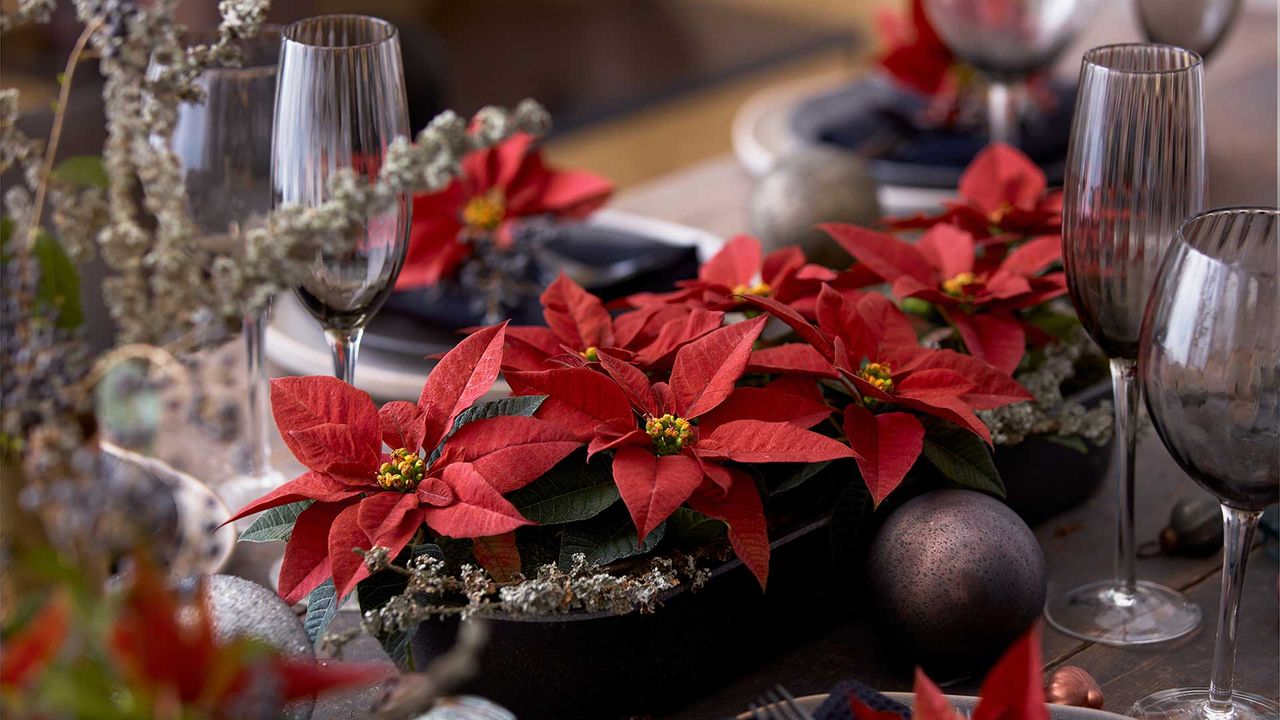

You might be wondering how to care for poinsettias as we enter the festive season. These jolly plants are a popular gift for the holidays, and if you look after them properly, they can last for much longer.
You probably won't want a wilted plant as part of your Christmas decorating ideas, so to keep your poinsettia thriving, there are a few key tips to remember. As with all indoor plant care, factors such as watering, temperature, and providing the right amount of light all play their part.
We asked the experts for their advice on caring for these cheerful houseplants. Below, you'll find all the essentials, including tips on helping them bloom again next year.
How to care for poinsettias, according to the pros
While poinsettias lift the spirits with their beautiful bracts, do remember that they have an irritant sap. So, similarly to amaryllis planted in pots (another popular winter houseplant), it's best to keep them away from curious pets and children. You may also wish to wear gardening gloves when handling them, such as these favourite gloves from Sarah Raven.
Choosing your poinsettia
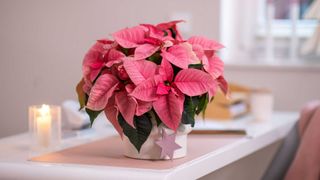
While red is the classic choice, poinsettias can also be found in pink and creamy hues
When picking out one of these alluring plants for your home, there are a few dos and don'ts to consider.
Poinsettia expert Dr Susanne Lux notes how a healthy poinsettia with the best chance of a long life will be dense and undamaged, with budding, yellow-green flowers in the centre of the coloured bracts.
"I advise against buying glittered plants," she adds. "As beautiful as the sparkle may be, it’s not good for poinsettias or our environment."
Sign up for the woman&home newsletter
Sign up to our free daily email for the latest royal and entertainment news, interesting opinion, expert advice on styling and beauty trends, and no-nonsense guides to the health and wellness questions you want answered.
Susanne also warns against choosing a plant that's been kept in a cold place. "Poinsettias placed in a dark corner of a shop, a draughty entrance, or outside in temperatures below 15°C usually lose their leaves within a few days of purchase and often die shortly afterwards."
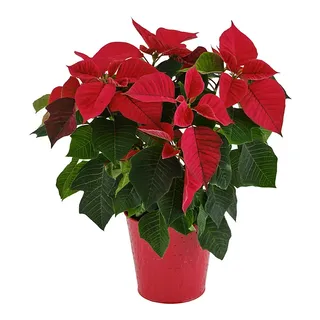 Plant only
Plant only
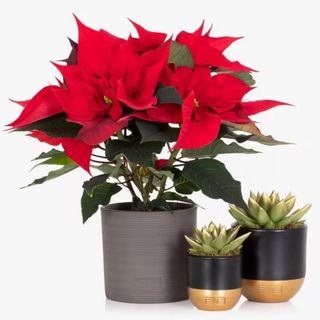

Dr Lux supervises market analysis in the green sector, including woody plants and perennials, bedding and balcony plants, and flowering indoor plants. She is the project manager for Stars for Europe, the European marketing campaign for poinsettias, as well as Pelargonium for Europe, which promotes geraniums.
How to water poinsettias
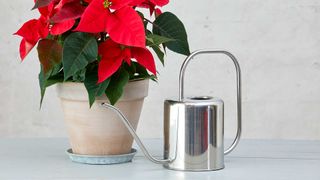
Avoid overwatering these plants
Knowing how to water plants properly is key when learning how to care for poinsettias. According to Jo Lambell, the founder of Beards & Daisies, they prefer a consistent level of moisture in their soil but don't like to sit in water.
"Allow the top inch of soil to dry out before watering again," she says. "This typically means watering every one to two weeks. Be sure to water thoroughly until it runs out of the drainage holes and avoid letting the pot sit in excess water, as soggy roots can lead to rot." Yellowing leaves can be an indicator of overwatering or poor drainage, she adds.
Claire Bishop, senior plant buyer of Dobbies, also notes how they like a humid environment, so recommends misting their leaves often. This should prevent them from drying out when you have your heating on in winter, she says.
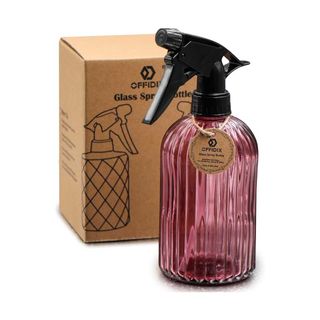
Keep your poinsettia and other humidity-loving houseplants happy over winter and beyond with this well-rated spray bottle from Offidix.

Jo Lambell, the founder of Beards & Daisies and author of The Unkillables, discovered her passion for houseplants in 2001 after transporting a 6ft monstera home on public transport ("I realised there had to be a better way to get plants delivered"). This sparked the idea for a business that makes plant delivery more accessible. As Beards & Daisies approaches its 10th anniversary, they offer a carefully curated selection of indoor plants, from prayer plants to palm trees. Jo and her Plant Folk team are all about spreading the plant love, sharing expert tips with both budding and seasoned plant enthusiasts. And with their 100% recyclable or compostable packaging, they’re keeping things green in more ways than one.

Claire has been part of the Dobbies team for over 12 years and was named in Horticulture Week’s 30 UK Indoor Plant Industry Leaders list. For the past seven years, Claire has held a position on the assessment panel for the RHS Chelsea Flower Show and Hampton Court Palace Flower Show, notably as panel lead for the last four years and in 2023, was appointed RHS Chair of Assessor for all RHS shows.
Providing the right conditions for your poinsettia

Poinsettias can make a striking feature in a room, but don't let them get too cold
Jo says, "The ideal temperature for poinsettias is between 18-21°C during the day, and no lower than 15°C at night. Keep them away from drafts, heaters, and cold windowsills, as sudden temperature changes can stress the plant."
In terms of light, Claire recommends placing them in a bright spot, where they’ll get at least six hours of indirect sunlight per day. "However, you should avoid direct sunlight as this could scorch the plant’s leaves," she adds. This tip applies when caring for peace lilies, too, especially in the summer.
Top tip: “When you get home, you’ll need to make the transition from cold to warm as stress-free as possible for the poinsettia, which means it’s best not to move it immediately into a very warm room," says Susanne. "In a cooler, lighter room such as the kitchen or conservatory, your poinsettia can acclimatise in peace." After a few hours, move it to its final location, she adds.
How to keep your poinsettia alive after Christmas, and encourage new blooms
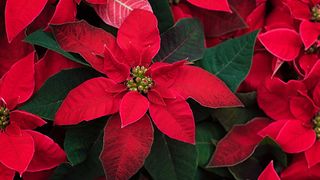
Long, dark nights in autumn will help poinsettias rebloom
"Once the festive period fades, reduce watering and allow the plant to rest," says Jo. "Cut it back to about 4-6 inches tall, repot if needed, and move it to a slightly cooler, less bright location." You can then move it outdoors when the weather is warm, keeping it in partial shade, she adds. Make sure you bring it back indoors before temperatures drop again – as tender plants, poinsettias need protection from frost.
According to David Denyer of Eflorist, creating a dark environment for poinsettias during the late summer or early autumn is key to getting them to bloom again. They need 12-14 hours of complete darkness every night for about six weeks before they can produce those red bracts, he says. "During the day, expose it to bright, indirect sunlight," adds Jo.
Top tip: You could also consider fertilising poinsettias with a liquid plant food throughout the spring and summer months, as Claire suggests. This will help to encourage blooms next Christmas.

David Denyer is a passionate florist with over 35 years of experience. His work has earned him numerous accolades, including being named Interflora's "Florist of the Year" twice and winning multiple Chelsea Flower Show Gold Medals. At Eflorist, David ensures that each bouquet reflects his dedication, making every arrangement a memorable gift. He’s particularly fond of poinsettias, which he believes add a beautiful and festive touch to any holiday celebration.
FAQs
Can poinsettias suffer from pest problems?
Pests can be troublesome for poinsettias, so it's worth keeping an eye out.
"Aphids, whiteflies, and mealybugs love to latch onto the delicate leaves," says David. "If you notice your poinsettia leaves curling or sticky, that’s usually a sign of pest infestation. You should immediately isolate the plant to prevent any spread to other plants and treat it with insecticidal soap or neem oil."
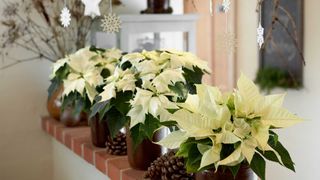
Inspect plants regularly for interlopers
How should you care for mini poinsettias?
“Mini poinsettias in tiny pots, gorgeous though they are, have a very small soil volume which means the root balls can dry out or become waterlogged very quickly," says Susanne.
She recommends checking the moisture of the soil daily if possible and watering them by immersion. "To do this, submerge the root ball completely in lukewarm water about every two to three days, or daily if necessary, and let it drain well when you take it out. After about 15 minutes, check whether any excess water has collected in the container or saucer and drain it off."
It's also worth knowing how to repot houseplants, as, according to Susanne, repotting mini poinsettias will help them last longer. She recommends using cactus compost for this, as it allows for good drainage. At Woman & Home, we like the look of the well-rated Westland's cacti and succulent potting mix, available from Amazon.
"A drainage layer and holes at the bottom of the pot will help prevent waterlogging," she adds.
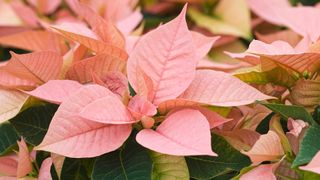
Repotting poinsettias can help them last longer
While poinsettias are a festive addition to the home, don't forget about your other indoor plants, too, when outdoor temperatures drop. If you're looking for more advice on how to care for houseplants in winter, our dedicated guide has plenty of practical tips.

The garden was always a big part of Holly's life growing up, as was the surrounding New Forest where she lived. Her appreciation for the great outdoors has only grown since then; she's been an allotment keeper, a professional gardener, and a botanical illustrator. Over three years ago, Holly started writing about plants and outdoor living full-time, first for Gardeningetc.com and now for popular lifestyle titles such as Homes & Gardens.
-
 Could they BE anymore influential? How Friends changed the world
Could they BE anymore influential? How Friends changed the worldThe influence of Friends has lasted decades. Here are just a few of the things we have to thank the show for...
By Natalie Denton Published
-
 Jan from Fear: What happened to the real life stalker and where is he now?
Jan from Fear: What happened to the real life stalker and where is he now?Prime Video's Fear is based on a terrifying true story - we look at who the real stalker was and what happened to him in reality
By Lucy Wigley Published